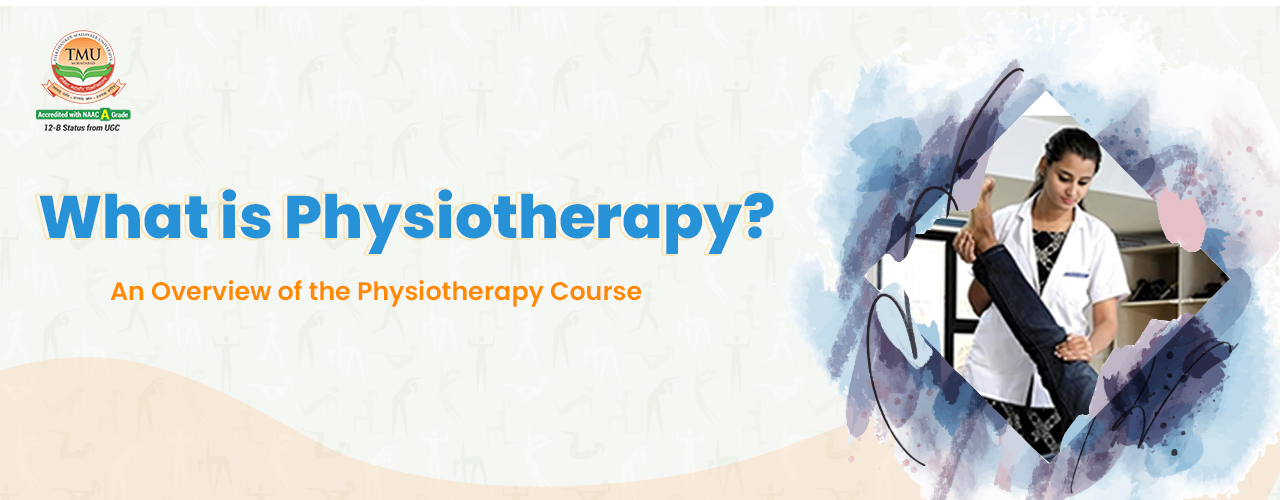What is Physiotherapy? An Overview of the Physiotherapy Course
Table of Contents
Physiotherapy, also known as physical therapy, is a healthcare technique that focuses on improving a patient's physical well-being by addressing injuries, illnesses, or disabilities through movement, exercise, and manual therapy. Whether you're dealing with chronic pain, recovering from surgery, or needing rehabilitation after an injury, physiotherapy plays a vital role in restoring your body’s functionality.
Definition and Importance of Physiotherapy
Physiotherapy is centred around the science of movement. It helps individuals of all ages maintain, restore, or improve their physical strength, mobility, and overall quality of life. By diagnosing physical issues and offering tailored treatment plans, physiotherapists help patients overcome limitations caused by injury, age, or health conditions.
Teerthanker Mahaveer University
Apply for Admission
Click Here To Apply for Admission
Who Needs Physiotherapy?
Physiotherapy isn’t limited to just athletes or those with severe injuries. It benefits a wide range of individuals, including:
- People with chronic conditions like arthritis or heart disease
- Those recovering from surgery or injury
- Elderly individuals needing help with mobility
- Patients with neurological conditions such as stroke or multiple sclerosis
Key Objectives of Physiotherapy
| Objective | Details |
| Pain Management and Rehabilitation | Alleviates acute and chronic pain, promoting faster recovery and healing. |
| Improving Mobility and Function | Enhances flexibility, strength, coordination, and overall movement ability |
| Restoring Physical Independence | Helps patients regain independence in daily activities and self-care. |
| Preventing Future Injuries | Uses exercise and education to reduce the risk of re-injury or complications. |
| Enhancing Quality of Life | Improves overall well-being by addressing physical limitations and discomfort |
How Physiotherapy Works
Physiotherapy is not a one-size-fits-all approach. Treatment plans are tailored to each individual, depending on their specific needs and health conditions.
| Aspect | Details |
| Assessment and Diagnosis | The physiotherapist assesses the patient’s condition through physical exams and medical history to identify the root cause of pain or dysfunction. |
| Treatment Planning | A personalized treatment plan is developed based on the assessment, targeting specific areas for improvement. |
| Education and Advice | Patients receive advice on posture, movement, and injury prevention to support recovery and prevent further problems. |
| Rehabilitation | A combination of therapies and exercises to restore normal function and mobility, often after injury or surgery. |
Physiotherapy Techniques
Manual Therapy
Manual therapy involves hands-on techniques, such as massage, mobilisation, and manipulation, to reduce pain and stiffness in muscles and joints.
Electrotherapy
Electrotherapy uses electrical stimulation to promote healing and reduce pain in injured muscles and tissues. It includes techniques like TENS (Transcutaneous Electrical Nerve Stimulation) and ultrasound therapy.
Exercise Therapy
Exercise therapy includes a range of exercises designed to improve strength, flexibility, and endurance. It is often used for rehabilitation after injury or surgery.
Use of Modern Technology in Physiotherapy
With advancements in technology, physiotherapy has embraced new methods such as robotic-assisted therapy, virtual reality, and wearable devices to monitor patients’ progress and ensure more accurate recovery.
Types of Physiotherapy
| Type of Physiotherapy | Details |
| Musculoskeletal Physiotherapy | Focuses on treating conditions affecting muscles, bones, and joints, such as arthritis and back pain. |
| Neurological Physiotherapy | Helps patients with neurological disorders like stroke, Parkinson’s disease, and spinal cord injuries. |
| Cardiorespiratory Physiotherapy | Aims to improve heart and lung function; commonly used for patients with COPD or after heart surgery. |
| Sports Physiotherapy | Specializes in the prevention and treatment of sports-related injuries, improving athletic performance. |
| Pediatric Physiotherapy | Focuses on treating physical conditions in infants, children, and adolescents, including developmental delays. |
| Geriatric Physiotherapy | Addresses issues related to aging, such as arthritis, osteoporosis, and balance disorders. |
The Role of a Physiotherapist
Responsibilities and Expertise
Physiotherapists are highly trained healthcare professionals who assess, diagnose, and treat physical issues. They use various techniques like manual therapy, therapeutic exercises, and equipment to help patients recover or improve mobility.
Physiotherapist-Patient Relationship
A strong patient-therapist relationship is key to effective treatment. Physiotherapists work closely with patients, offering personalized care and support throughout the recovery journey.
An Overview of the Physiotherapy Course
| Aspect | Details |
| Eligibility Criteria | Requires a background in science (biology, chemistry, physics). |
| Course Duration | Typically 3 to 5 years, depending on the program (Bachelor’s, Master’s). |
| Subjects Covered | Human anatomy, physiology, biomechanics, pharmacology, physiotherapy techniques. |
| Practical Training | Includes internships and hands-on experience in clinics and hospitals. |
| Internship Requirements | Mandatory internship period ranging from 6 months to 1 year. |
| Degree Awarded | Bachelor of Physiotherapy (BPT) or Master of Physiotherapy (MPT). |
Career Opportunities in Physiotherapy
Job Roles and Work Settings
Physiotherapists can work in hospitals, private clinics, sports facilities, rehabilitation centers, or even start their own practice.
Salary Expectations
| Experience Level | Expected Salary (per month) |
| Entry-Level (0-2 years) | ₹15,000 - ₹30,000 |
| Mid-Level (3-5 years) | ₹30,000 - ₹50,000 |
| Experienced (5-10 years) | ₹50,000 - ₹70,000 |
| Senior-Level (10+ years) | ₹70,000 - ₹1,00,000 or more |
| Specialized Physiotherapists | ₹1,00,000 or more, depending on specialization, location and other factors. |
Advantages of Pursuing a Physiotherapy Course
Job Security and Demand
The demand for physiotherapists is growing as the global population ages and awareness about physical health increases.
Opportunities for Specialization
Physiotherapy offers various fields of specialization, from sports to neurology, allowing professionals to focus on areas that interest them.
Challenges in the Field of Physiotherapy
Physical and Emotional Demands
The job can be physically demanding, as physiotherapists often assist patients with movement and exercise. Emotional resilience is also important, especially when dealing with critically ill or recovering patients.
Maintaining Work-Life Balance
Like any healthcare profession, maintaining a balance between professional responsibilities and personal life can be challenging, especially in high-demand areas.
Conclusion
Physiotherapy is an integral part of modern healthcare, offering numerous benefits to patients with physical ailments or disabilities. The physiotherapy course provides a thorough understanding of the human body, medical conditions, and rehabilitation techniques, preparing graduates for a rewarding and impactful career.
FAQs
Q: What qualifications are needed to become a physiotherapist?
Ans: A bachelor's degree in physiotherapy (BPT) is typically required. Some may pursue further specialization through a master's degree.
Q: How long does it take to complete a physiotherapy course?
Ans: The duration of a BPT course is generally four years, with an additional six months to one year for internships.
Q: Is physiotherapy a good career?
Ans: Yes, it is a growing field with high demand for skilled professionals, offering good pay and job satisfaction.
Q: What is a physiotherapist used for?
Ans: A physiotherapist is used for diagnosing and treating physical impairments, injuries, and movement disorders. They help improve mobility, relieve pain, and restore function through exercises, manual therapy, and rehabilitation techniques, aiding recovery from injury, surgery, or chronic conditions.
Q: What is the main role of a physiotherapist?
Ans: The main role of a physiotherapist is to assess, diagnose, and treat physical conditions and injuries to restore movement, improve function, and alleviate pain through personalised therapy plans, exercises, and rehabilitation techniques.















